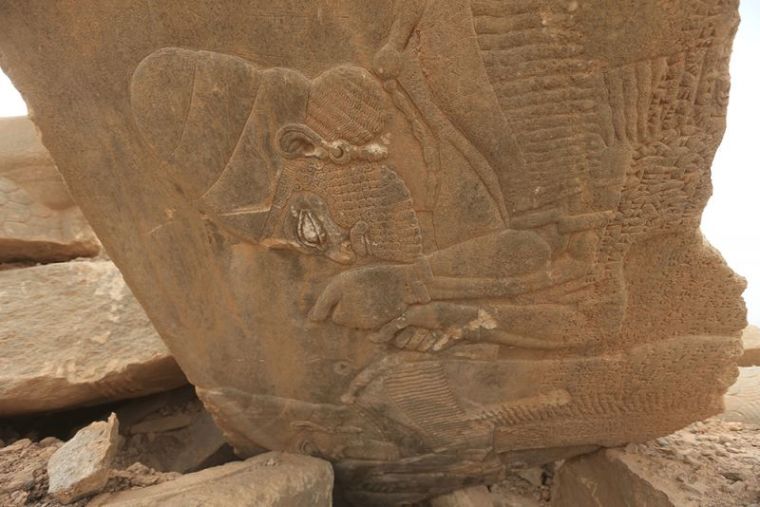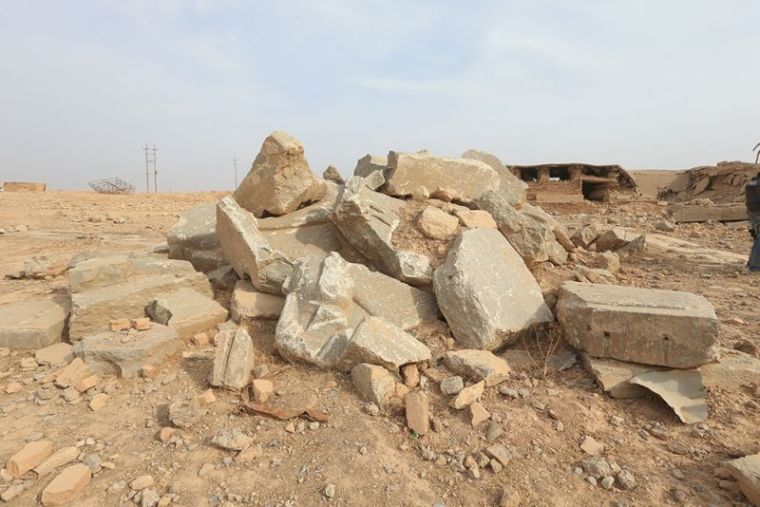Ancient City of Nimrud in Bible's Book of Genesis Destroyed by ISIS (Photos)
The Iraqi army has regained control of the country's ancient Assyrian city of Calah, mentioned in the Bible's first book Genesis and also known as Nimrud, from Islamic State but the pictures emerging from the ancient landmark reveal how the jihadists sought to wipe out its monuments and statues due to their "non-Islamic" character.
Located on the Nineveh Plains about 20 miles south of Mosul, the excavated remains of the city have been reduced to rubble, according to pictures and a video published by the U.K.'s Daily Mail. The city was liberated on Sunday.
In the video, Islamic State terrorists with sledgehammers and power tools can be seen breaking artifacts before rigging the site with large barrels of what appears to be explosives, apparently to eliminate idols that are forbidden by its extreme interpretation of Islam.
Calah is mentioned in Genesis 10:8–12, "Cush was the father of Nimrod, who became a mighty warrior on the Earth. He was a mighty hunter before the Lord; that is why it is said, 'Like Nimrod, a mighty hunter before the Lord.' The first centers of his kingdom were Babylon, Uruk, Akkad and Kalneh, in Shinar. From that land he went to Assyria, where he built Nineveh, Rehoboth Ir, Calah and Resen, which is between Nineveh and Calah — which is the great city."
The Islamic State, also known as IS, ISIS, ISIL or Daesh, has left behind a trail of destroyed heritage sites, including a 2,900-year-old ziggurat in Nimrud in northern Iraq, the Smithsonian magazine reported.
While experts are still waiting for permission to examine the damage, satellite images indicate that the ziggurat is no more. The site still needs to be secured and swept for mines and booby traps left behind by IS fighters.
Michael Danti, academic director of the University of Pennsylvania Museum and the American Schools of Oriental Research, who was involved in recent excavations in the Kurdistan Region along the Iraq-Iran border, has called for emergency site assessments to prevent further damage, Rudaw reported.
"It is part of cultural cleansing," Danti was quoted as saying. "ISIS tries to destroy cultural diversity and is targeting the cultural memory by attacking places like Nimrud and Hatra," a nearby archeological site, a UNESCO World Heritage site still under control of IS.
Satellite pictures show that "heavy machinery was used to create new earthen embankments and to dig into the existing archaeological material."
The ruins of the ziggurat were about 43 meters high. In ancient times, these towers were used for making astronomical observations, even as they also served other ritual and symbolic functions.
"The ziggurat mound is the highest point in the nearby landscape, making it an ideal defensive position for encroaching forces. However, the archaeological site is located in a remote area far from strategic points," the American Schools of Oriental Research's Cultural Heritage Initiatives said in a statement. "Alternatively, like the Northwest Palace and the Nabu Temple at Nimrud, the attack could have served a dual purpose: intentional destruction for the composition of future propaganda and retributory violence to demoralize local populations and goad invading military forces. ISIL militants could also have been searching for antiquities in the mound."


























